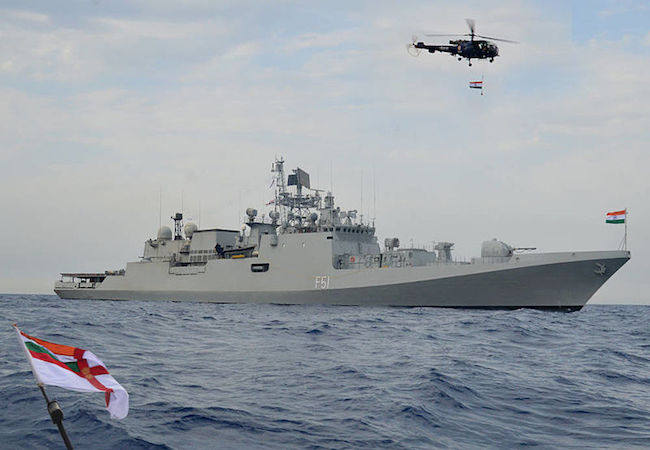Stemming the tide: India’s geopolitical future in IOR

When it comes to the geopolitics and control over the seas, Alfred Thayer Mahan—the renowned geopolitical and naval strategist—comes to mind. His theory of control over the sea—a determinant of global predominance—is very much relevant today. In 19th century, British could colonise the whole world with their shear naval strength. The 20th and 21st century saw the USA dominating the world waters and replacing the British. The six fundamental elements of sea power listed out by Mahan—the geographical position, extent of territory, the size of the population, ability for physical confrontation, character of the people and of the government of a countryfitted well for the British as well as the USA.
Today, these fundamental principles perfectly place India at the centre of geopolitics and as a prospective player substituting the waning American dominance in the Indian Ocean and its surroundings. India is situated at the centre of the Indian Ocean flanked by two strategically important seas and at the confluence of Eastern and Western hemispheres. This also makes it a major player in the decision-making process on issues concerning the politics and security of the region. These include the maritime cooperation between India and the countries located in and around the Indian Ocean.
China has inculcated Mahan’s sea power theory as well as Mackinder’s heartland theory as doctrine of its foreign policy and is aggressively expanding its tentacles all around the globe. An increasingly assertive power of the 21st Century, it has changed the face of international system in the last decade. Its ambitious Belt Road Initiative is taking a toll on regions of Eurasia and India Ocean Region (IOR). The expansion of its naval capacities beyond its territorial extent has shaped a new geopolitical narrative in the world. With its growing clout in the Indian Ocean, it has become imperative of pulling the strings in the region. The vast ocean resources, components of blue economy, are suitable elements for major power competition in the IOR.
The Indian Ocean is considered to be part of the global commons as it is one of the world’s most shared water resource and almost all the countries have access to it. It has the world’s largest marine resources, fisheries, aquaculture and bears the potential for a thriving blue economy. It is also known for its abundance of resources, specifically in the sectors of sea-bed mining, rare earth minerals, ocean energy and shipping activities. The polymetallic nodules and deposits of massive sulphides are of commercial interest to countries in the Indian Ocean. These minerals are of the size ranging from golf-to-tennis ball containing nickel, cobalt, iron and manganese that have been formed over millions of years on the beds of seafloor. Thus, Indian Ocean is becoming a hub for economic exploration activities which are at the centre of the blue economy.
Indian Ocean has seen an intense global activity in the past decade as most of the important sea lanes and trade routes of the world pass through this region. It provides the main outlet for the transport of petroleum and petroleum products from the oilfield in the Gulf to various parts of the world. The crucial choke points such as Strait of Hormuz, Malacca and Ba’bal Mandab through which transport of oil bound for the USA, India, countries in Southeast Asia, China, Japan and Australia demonstrate the significance of this region. Apart from the conflicts that could arise as a result of competition between these countries, piracy and terrorism are some of the other security related issues. By giving importance to the security aspect of the IOR, the conservation and protection of its blue economy adds to the priority list of these countries.
With China already expanding aggressively in the far-East and Indo-Pacific, it is now aiming to gain power and influence in and around the IOR. India equally fits to be a potential player of this global common as it is greatly dependent on the IOR for its development; 90 per cent of its trade is greatly reliant on merchant shipping and imported sources of energy. Most importantly, India’s freedom of navigation and trade is determined by the freedom of the coastal surface. Thereby, this region could prove as India’s pathway to rise as a superpower in the Asia-Pacific region.
India’s geostrategic location will help it to improve the connectivity between the littoral states and proves it to be prosperous enough to be at the centre of the wide plethora of resources. However, with resource wealth comes competitors and thus security must be a priority for India to conserve the blue economy of the Ocean. This will eventually lead to the conservation of blue economy of the region which is a prospective axis for economic activities and will help in India’s growth.
China, being the “preferred one” among India’s neighbours in the IOR, has vexed India’s regional competency and is keeping it at a bay. However, in order to counter anxious and conspicuous advances of the Chinese, India has established military checkpoints in a ‘Triumvirate’ comprising Mauritius, Madagascar and Seychelles. These island countries in the Indian Ocean have become the new home for Indian strategic and diplomatic interests. These states are culturally inclined to India’s ethnically diverse background and its sub-continental geography is the icing on the cake.
With China and India battling it out in the Indian Ocean, the island nations in the region have caught themselves in this bipolar gimmickry. As noticed, China’s rise in the Indian Ocean through its deceptive strategy has paid off well and to halt this, India’s southern partners in IOR have been approached to extend their cooperation in the matter. Even though India does not have the propensity to finance large-scale projects, it can assist these countries in their trade as well as promote their tourism back home. India should keep aside the protests and resentment faced by its projects and play the cultural card along with its democratic credibility.
India should also convince these nations and build a new den in its own backyard and restrict China, provided it does not make a policy shift in appeasing others and not be an old hat by perpetrating ignorance. What needs to be done by India is to first counter Chinese growing influence and simultaneously build alliances such as Quad in the Indo-Pacific and others with countries of this region to develop the region and harness its potential in exploring and utilising its ocean resources.




